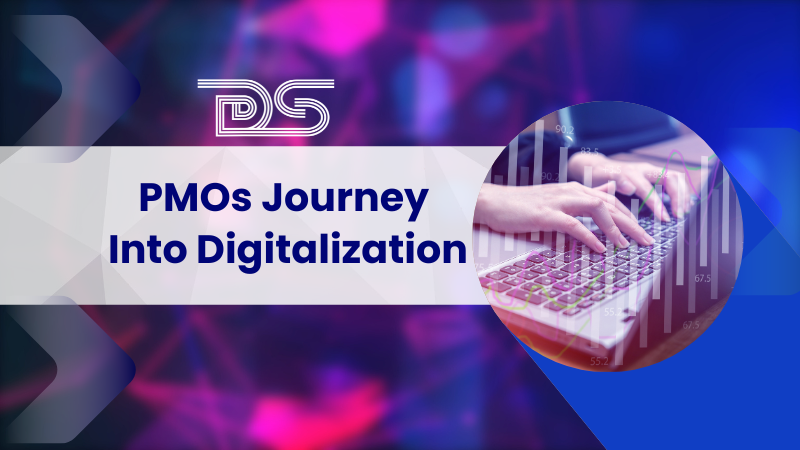
by Dharam CW2 | Jul 11, 2024 | General
Many PMOs recognize digitalization as an essential step in their organizations’ journey toward project management maturity. As a result, the Project Management Office (PMO) must shift its focus from project governance and delivery to supporting digital transformation.
To keep up with the evolving demands and needs of an increasingly digitized world, digital transformation has to be drifted through organizations of all shapes and sizes. However, many realize that successful digital transformation entails changing foundational cultures, structures, and methodologies and implementing digital tools. As organizations expand to accommodate this change, the PMO’s role within those organizations must change to do the same.
Digitalizing PMOs
Digital transformation is a familiar idea. Businesses constantly look for new ways to adapt and leverage emerging technologies to improve their business processes. Before the pandemic, PTC research found that 70% of organizations had or were working on a digital transformation strategy.
The PMO is crucial to achieving an organization’s strategic goals. If PMOs are to be an organization’s strategic drivers, they must expand their role beyond its traditional boundaries. They must assume their strategic role by leading change and capitalizing on opportunities in the digital space. PMOs must be at the forefront of emerging technologies, constantly evaluating opportunities and implementing new strategies. The recent pandemic and sudden shift to remote work have highlighted the challenges of developing community and culture through digital spaces. Here are some ways that PMOs can help the organization drive into digital transformation.
Five ways the PMO drives digital transformation
- PMOs can inspire and encourage change.
- PMOs act as the strategic arm
- PMOs provide support and insight.
- PMOs properly manage transformations.
- PMOs enable successful digital adoption.
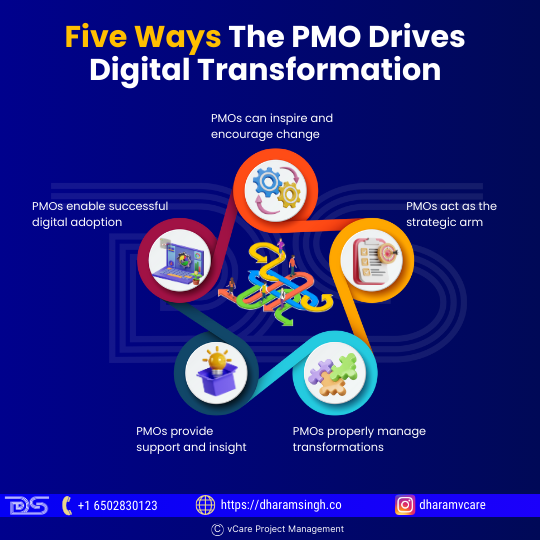
Five ways the PMO drives digital transformation
How PMOs can aid an organization’s digital transformation
The nature, ownership, and stakeholders of IT strategy, governance, and management activities are changing dramatically due to digitization. According to Gartner research, 87% of organizations prioritize digitization. Furthermore, technology is now responsible for 77% of an executive’s top priorities.
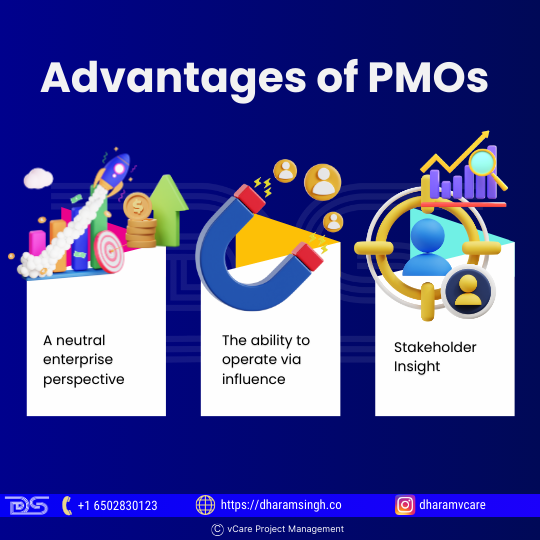
Advantages of PMOs
As a result, PMOs are under intense pressure to transform. Unfortunately, their project, program, and portfolio management processes are designed for predictability and consistency rather than the speed and flexibility required to meet digital demand. Most PMOs have three significant advantages, which are either inherent due to the PMO’s role or location or have been developed through previous experience:
- A neutral enterprise perspective: As capital allocation and portfolio prioritization approaches change to enable the funding flexibility required for digital work, the PMO’s impartial, enterprise-wide perspective on demand, investment, and resource utilization is hugely valuable.
- The ability to operate via influence: As organizational boundaries become more fluid and who “owns” project management becomes less certain, influencing and enabling others, rather than direct ownership, becomes even more critical.
- Stakeholder insight: As digitization spreads throughout the business and accounts for an increasing proportion of work, there are more first-time stakeholders and greater stakeholder complexity for each piece of work. Understanding the preferences of these various stakeholders and experiencing synthesizing their feedback becomes critical in delivering results from digital work.
Elements Driving Digitalization
Traditional businesses worldwide have long recognized that digital transformation is the key to thriving in a fast-paced world. Digital transformation involves integrating digital technology into all aspects of a business. It fundamentally alters how businesses operate and provide value to customers. It increases efficiency, transparency, customer experience, employee engagement, and culture and saves time and money. Modern digital tools have elevated the project management process to new heights.
The following are the seven critical elements of a successful strategic digital transformation framework:
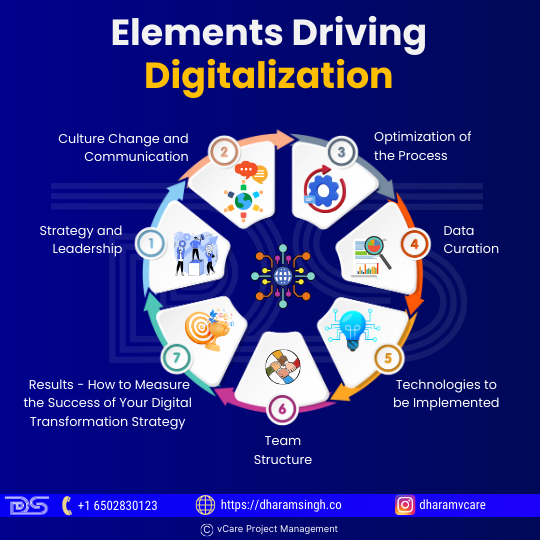
Elements Driving Digitalization
- Strategy and Leadership
An effective game plan is an obvious but frequently overlooked component of a digital transformation strategy. Instead, what matters is “how and who” formulates the strategy. A basic strategy and the appropriate technologies can help you digitize or digitalize your business, but transformation requires the right mindset and guidance. As a result, strategy combined with the right leadership is the first and most important component of an effective digital transformation strategy.
Visionary leadership combined with the appropriate digital transformation strategy can achieve a better, smoother, more cost-effective, and time-effective plan for your business’s transformation.
- Culture Change and Communication
Prepare for a massive cultural shift. A company’s clients and employees are typically resistant to significant changes, making implementing any transformation challenging. However, any successful digital transformation program must include culture. Therefore, giving your employees advanced training in good communication will be advantageous.
- Discuss the digital transformation strategy with your employees and how it will benefit all stakeholders.
- Conduct training sessions with your employees ahead of time to prepare them.
- You can prepare your employees by demonstrating the importance of aligning culture with new initiatives.
- Optimization of the Process
Every business has various processes and operations that can be improved to make workflows more efficient and effective. As a result, when developing a digital transformation strategy, consider business process optimization.
The strategy must optimize the business process while meeting customer and internal team goals. The digital transformation strategy must cover all interconnected business processes to achieve maximum output.
- Data Curation
One of the primary reasons for implementing digital transformation is to eliminate your business’s pain points for your team and your customers. But how will you know what these aches and pains are?
Data analysis and integration can assist you in locating them. People frequently choose their preferred technologies when developing transformation strategies before analyzing their data. Data analysis and the dissemination of its results can assist the team in identifying the best solutions to problems, leading to developing a better digital transformation strategy and making the most of the transformation process.
- Technologies to be Implemented
Finding the right technologies for your business is one of the most crucial steps in creating a digital transformation strategy. Introducing new technologies into your business will necessitate a significant financial investment, so it must be done correctly to avoid the need for additional funds. Any impactful strategy for digital transformation will always include options and budget constraints to help you make the best decision possible. Whether dealing with legacy system updates, application modernization, or implementing entirely new digital systems, you must find the best technology.
Some cutting-edge technologies that must be incorporated into your digital transformation strategy are:
- Cloud and Distributed Platforms
- Data Analytics & Artificial Intelligence
- Digital Experience and Digital Reality
- Team Structure
Harvard Business Review says digital transformation is about people, not tools. As a result, team structure is a determining factor in delivering results by the Digital Transformation Strategy.
The scope of the project should determine the team structure. The following components should be included in the digital transformation initiative:
- Pack of Leaders
- Business Experts
- The cast of Coders and Designers
- Results – How to Measure the Success of Your Digital Transformation Strategy
Your company’s digital transformation outcomes will greatly influence how you lay out your strategy. The outcomes will always vary depending on the practices and technologies used. Your digital transformation strategy’s success is dependent on its agility. First, of course, you must stick to your detailed strategy, but you must also be open to changes if things don’t go as planned.
By developing an effective, clear, and robust digital transformation strategy, you can ensure your company’s digital transformation goes as smoothly as possible. A digital transformation strategy is similar to a personalized road map for significant changes in your business operations. However, it requires significant financial investment, time, and technical expertise.
From Traditional PMO to Agile
Traditionally, PMOs have focused on maintaining project control to complete projects on time and within budget. However, in today’s increasingly complex and changing competitive environments, agile management is gradually displacing more traditional management methods; PMOs that remain anchored in this “classic” management model risk disappearing if they do not set the following objectives:
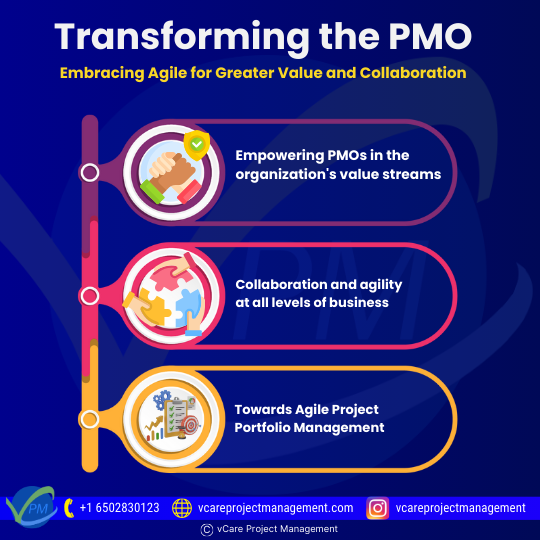
Transforming the PMO
- Empowering PMOs in the organization’s value streams
Organizations are now focusing on the value they provide to their customers and how different areas and departments contribute to that value creation. Suppose PMOs stick to their command and control model to ensure that projects are delivered on time and within budget. Their contribution to the organization’s value streams will be marginal, and senior management will view them as an unnecessary expense for the company.
- Collaboration and agility at all levels of business
Silo-based organizational models need to gain ground in agile and collaborative environments. As a result, PMOs must evolve beyond simply providing Project Managers with the tools they need to complete the organization’s projects.
On the one hand, PMOs must maintain open lines of communication with senior management to align the Project Portfolio with the organization’s goals. On the other hand, it serves as a reference point for stakeholders and project work teams, providing real-time information on project status and support at all levels for proper project implementation.
- Towards Agile Project Portfolio Management
Change is the norm in this new competitive environment, with highly volatile markets demanding businesses to bring products and services to market as quickly as possible. As a result, company objectives can shift dramatically quickly, necessitating a rethinking of project portfolio prioritization. This phase is where PMOs must adapt to this new environment and manage key project management issues like prioritization, resource management, budgets, or delivery dates in an agile manner, as well as learn to react to changes in their project portfolios in an agile and efficient way without losing sight of the organization’s objectives.
Post-pandemic challenges for PMO
If PMOs establish these three goals, they might avoid extinction because senior management will no longer recognize their value to the organization.
It will be challenging, and the Project Management Office will face several challenges as it adjusts to the new reality. In particular, the PMO will face some challenges for its role to be perceived as critical to the organization’s value streams:
- Coincide the project portfolio with the overall strategy of the organization.
- Resource management is a real challenge for PMOs.
- Responsiveness to changes in the project portfolio.
- Fluent in communication with the organization’s senior management.
- Embrace Agile Leadership.
- Standardization of processes and workflows.
- Renewal of project portfolio management tools.
Mitigating mediocre implementation of Programs
There are always equal chances of success and failure in programs/projects. As a result, it is critical to understand how to avoid and overcome project failure. There are numerous reasons why a PMO succeeds or fails. Still, the most common reasons for failure are often not related to process or technology issues but to “people issues” in an organization.
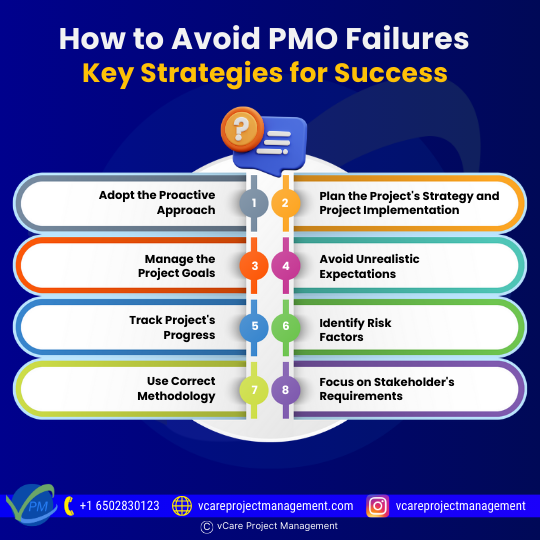
How to avoid PMO Failures
Here are the most common reasons why PMOs fail:
- Adopt the Proactive Approach
After many years, project managers gain the skills and knowledge needed for the current project from their experience. As a result, an experienced and highly skilled project manager is equipped to deal with customers and avoid project failure. If you are new to project management, consult a professional mentor to discuss your concerns and receive appropriate advice based on their experience. If you have project management experience, you should apply your skills and knowledge to the project and be aware of the common causes of project failure.
- Plan the Project’s Strategy and Project Implementation
The most important stage of any project is planning. Most of the time, proper attention is not given during the planning stage. If you plan properly, you will increase the project’s chances of success. After scheduling your project, use the Project Management Life Cycle to begin project execution.
- Manage the Project Goals
It would be best to document the project’s decisions, actions, and outcomes before beginning, during, and after completion. To avoid project failure, it is always necessary to ensure project deliverables and work appropriately with customer requirements. Never rely on understanding, verbal agreements, or memory for project implementation decisions.
- Avoid Unrealistic Expectations
Always set realistic expectations and time frames with stakeholders, team members, or customers to meet your project’s deadline. This move is related to the proper project start but goes deeper until completion. To avoid project failure, realistic expectations for team members must be set based on their capabilities. It would help if you encouraged them to work enthusiastically and push themselves beyond their comfort zone to meet the project’s objectives.
- Track Project’s Progress
Project planning will assist you in determining where your project should be now. In addition, you should know how much of the work has been completed, whether your work is on schedule, proceeding as planned, and so on. These three parameters govern any project and are critical in preventing project failure.
- Identify Risk Factors
The best way to avoid risk is to identify, analyze, and respond to risk factors. So, if you identify the risks and potential issues early on in the project, your project team can avoid them with appropriate actions. In addition, identifying and resolving risk factors will assist the project manager in lowering the likelihood of project failure. As a result, you can perform proper risk management and avoid project failure.
- Use Correct Methodology
One of the most important decisions a project manager must make is the methodology to use for project management. What you choose will have a significant impact on teamwork. However, each methodology has advantages and disadvantages depending on the project type and scope. Here are some top project management methodologies to consider.
- Waterfall method
- Agile/Scrum
- Hybrid approach
- Critical Chain Project Management
- Integrated Project Management Technique
- Critical Path Method (CPM)
All project management methodologies cannot be regarded as the best for all projects, so one can understand the project requirements and select the best option. The correct methodology will assist you in achieving the project goal within the specified time frame, thereby avoiding project failure.
- Focus on Stakeholder’s Requirements
As we all know, a project will only succeed if it meets its objectives and exceeds the expectations of its stakeholders. Therefore, to be successful in project management, all team members must be actively involved in the project and committed to its success. Devoting entails writing down the following stages:
- The competent initiative assists the team in implementing various tasks throughout the project life cycle.
- Adequate funding ensures the organization’s cost-generating department has enough money to fund the projects.
Final Thoughts
In today’s fast-paced and dynamic business environment, agile working methods might provide significant added value that should be noticed.
Digitalization is making projects more complex. As a result, the use of technology to manage projects is growing, and project teams must be cross-functional to achieve project goals. Agile project management provides an opportunity to respond quickly to new requirements and be more visible in the market. For organizations that use a traditional approach to project management, the transition to an agile PMO is part of their digital and agile transformation.
It should be noted that this is not an evaluation of “better” or “worse” methods. When used correctly, each project management method can reveal its strengths. It is critical to think about, use, and improve them.
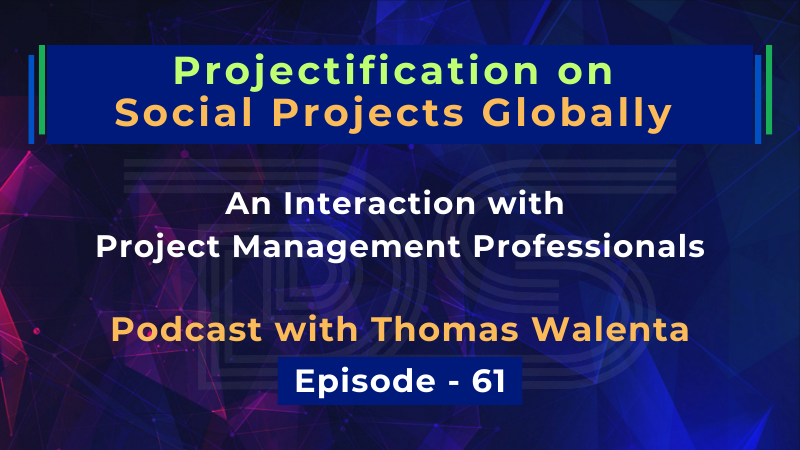
by Dharam CW2 | Feb 29, 2024 | Project Management
Projectification on Social Projects Globally | Thomas Walenta | Dharam Singh | Episode 61
Dive into a riveting discussion on the transformative power of global project management in the latest episode of our podcast, featuring the esteemed Thomas Walenta and myself.
🌐 Episode 61 explores the concept of ‘projectification’ and its profound influence on social projects worldwide, dissecting the intricate dynamics between project management and societal advancement.
🔍 We delve into:
– The burgeoning impact of project management on society and global practices.
– Unique challenges and requirements faced by the public sector in project portfolio management.
– Strategies for government organizations to embed a robust project management culture.
– The ripple effect of projects on societal structures and organizational operations.
– Analyzing and measuring project quality against stringent criteria.
This episode is an essential listen for senior project, program, and portfolio management professionals seeking to grasp their work’s far-reaching implications on society and understand how projects are becoming the bedrock of operational strategies globally.
🎧 Tune in to gain invaluable insights that will redefine your perspective on the project’s role in societal development.
▶️ Watch now: https://youtu.be/rMb7BJ6TuZA
🚀 Elevate Your Project Management Career:
– Register for my upcoming PgMP/PfMP Success Story Webinar: https://bit.ly/4bd68h8
– Book an obligation-free consultation session on Project management Career, training, and certifications: http://talktodharam.com
– Discover training offers and certification discounts: https://bit.ly/3jWVepD
– Stay updated with our Q&A series and certification success stories by subscribing to the vCare Project Management YouTube channel at https://bit.ly/2YF0wJl
– Follow my podcasts and interviews with Project Management Experts on YouTube at https://bit.ly/2NDY8wd
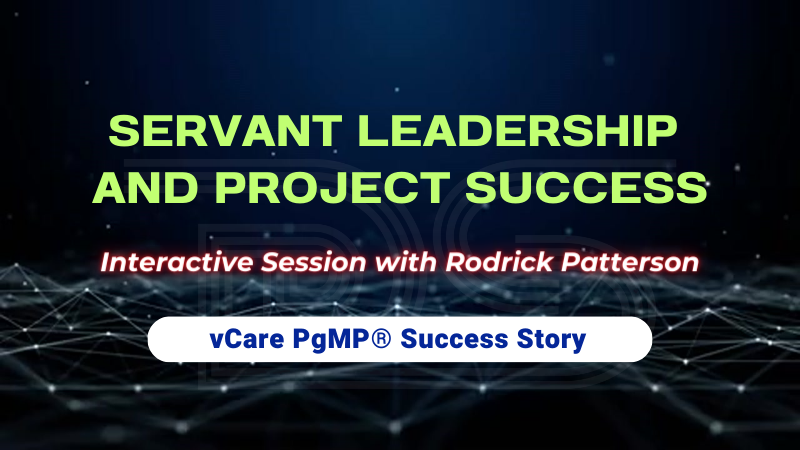
by DharamCW | Feb 13, 2024 | Professional Development Webinars
Servant Leadership and Project Success | Free Webinar with Rodrick Patterson | 1 PDU
I’m excited to invite you all to a thought-provoking session with Rodrick Patterson, PgMP, PMP, CSCP, Expert, Founder, President & CEO of RRP & EDU Consulting from Jackson, Mississippi, United States, renowned for his strategic Project, Program, and Portfolio Management insights. This webinar is a must-attend for those ready to embrace the shift toward servant leadership in the project management realm.
🔑 In our conversation, Rodrick will shed light on:
– Characteristics of servant leaders in project and program management.
– The transition from command-and-control to employee empowerment.
– Overcoming barriers in current leadership models.
– Long-term strategies for team development and effectiveness.
Session Date: 23rd February 2024 / 24th February 2024
Session Time: 12:30 PM – 01:30 PM (PST) / 01:30 PM – 02:30 PM (MST) / 02:30 PM – 03:30 PM (CST) / 03:30 PM – 04:30 PM (EST) / 05:30 PM – 06:30 PM (BRT) / 08:30 PM – 09:30 PM (GMT) / 07:30 AM – 08:30 AM (AEDT) / 09:30 AM – 10:30 AM (NZDT)
🔗 Secure your seat and elevate your leadership skills: https://bit.ly/3S53K3a
📅 Don’t miss this chance to refine your leadership approach and drive your team towards remarkable achievements.
Earn 1 PDU and join the ranks of project professionals who lead with service, empathy, and vision.
🚀 Elevate Your Project Management Career:
– Book an obligation-free consultation session on Project management Career, training, and certifications: http://bit.ly/2SbhTOK
– Discover training offers and certification discounts: https://bit.ly/3jWVepD
– Stay updated with our Q&A series and certification success stories by subscribing to the vCare Project Management YouTube channel at https://bit.ly/2YF0wJl
– Follow my podcasts and interviews with Project Management Experts on YouTube at https://bit.ly/2NDY8wd
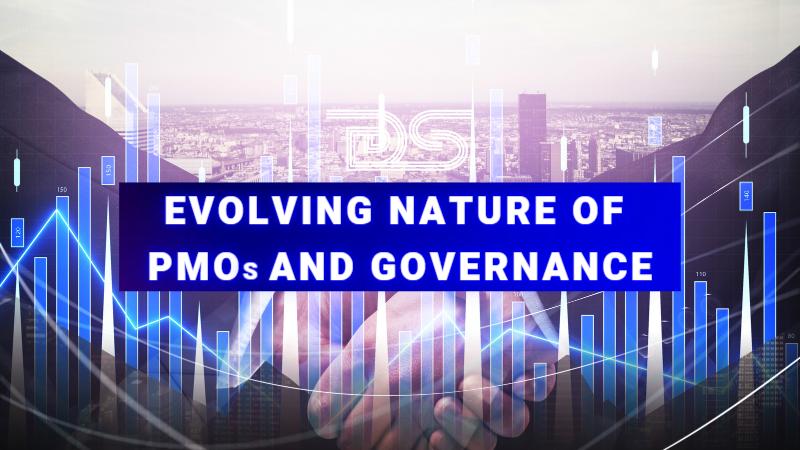
by DharamCW | Sep 8, 2023 | General
From a strategic standpoint, the PMO is critical in project management. Unlike project management, which focuses on the day-to-day operations of a project team, the PMO serves as a framework for project managers, offering PMO methodologies and templates for managing programs inside an organization. In addition, it manages the project management resources required to sustain and deliver projects.
Project management offices (PMOs) are evolving from purely administrative to strategic roles. They are rethinking PMO operations, adopting new technology, and implementing new project management operating models. The evolved PMO is a new PMO concept that is gaining traction. A creative, strategic, and adaptive PMO designed to help modern organizations deal with the volatility of today’s market conditions.

Functions Of A Project Management Office
Functions of a Project Management Office (PMO)
A project management office (PMO) is the foundation of a successful project management strategy in a business. It is a function that gives decision-support information but does not make choices.
A project management office (PMO) supports project delivery mechanisms by ensuring that all business change in a company is controlled. PMOs perform various duties, and their services depend on the department’s maturity and the PMO personnel’s talents. At its most basic, the PMO assists project management teams in making funding, prioritizing, and resource choices. The most mature PMOs provide the following:
1. Governance: The PMO ensures that the appropriate individuals make the correct decisions based on pertinent information. Audits or peer reviews, designing project and program frameworks, and maintaining accountability at all levels are all part of the governance role.
2. Transparency: The PMO delivers information as a source of truth. Information should be relevant and accurate to promote good decision-making and be presented to individuals understandably.
3. Reusability: The PMO fosters knowledge sharing. This aspect prevents project teams from reinventing the wheel and positions the PMO as the hub for lessons learned, templates, and best practices.
4. Delivery support: By minimizing bureaucracy and offering training, coaching, mentoring, and quality assurance, the PMO makes it easier for project teams to accomplish their duties.
5. Traceability: The PMO manages paperwork, project history, and organizational knowledge.
In reality, most PMOs will do various tasks and offer services tailored to the organization’s requirements.
How Business Agility Drives A Shift In Focus For Today’s PMOs
Forward-thinking companies are fast learning that “simply getting the job done” will not equip them for long-term company success. To be successful in business today, firms must provide products and services that satisfy their clients while constantly innovating to grow their markets.
Historically, PMOs were responsible for managing tactical operations that supported project development and implementation. Today’s Corporate leaders recognize that to stay ahead of the market; they need to exploit new possibilities while limiting unanticipated risks – this necessitates a new approach to planning, building, and delivery. Maintaining consistent levels of project success involves more than an organized strategy; it demands a company’s collective attitude to accept required disciplines while staying flexible enough to respond to changes in their business.
1. A major project fails — badly: When an expensive, strategic initiative fails in a competitive market, it compels a company to rethink its strategy. A third of the organizations polled cited a big failure as the impetus for shifting emphasis.
2. A project goes over budget: An underlying driver is cost reduction; project success at higher-than-expected costs decreases profitability and damages customer relationships.
3. A PMO aids a strategic project to succeed: Success, on the other hand, is a catalyst for change. Therefore, the following important reason for building a strategic PMO would be to capitalize on the momentum produced by the successful project.
4. Market competition forces stronger disciplines: Maintaining market share and growing at a controllable rate encouraged larger firms to create consistency to innovate. The capacity to pivot and explore possibilities prompted smaller businesses to establish a strategic PMO.
Key Factors to a Successful PMO Transformation
Established businesses and fast-growing firms are both adapting to changing business environments brought on by competition, acquisitions, developing technology, and new risks. As a result, the importance of alignment, built-in quality, transparency, and the capacity to execute across various project endeavors has never been greater. Innovative design thinking, continuous delivery, excellent quality, and a never-ending drive for improvement are some of the essential characteristics of a modern-day PMO. Here are some causes driving PMO evolution and the seven elements required to turn a typical PMO into a transformation management office (TMO).
Drivers behind the PMO Evolution
Due to increased external business environment constraints, businesses must achieve rapid and substantial value from their projects and initiatives. This aspect means shorter delivery cycles, the adoption of developing technologies, and regularly changed priorities for the PMO. To achieve this transition, the PMO must move its focus from project execution technique to value-driven business results. Change drivers are often aligned with three fundamental needs:

Drivers behind the PMO Evolution
1. Capacity and skills:
- Specific domain areas of technical expertise required
- Extra capacity required
2. Rapid Execution:
- Organizations require rapid execution to address immediate concerns
- No time to plan, but need to execute now to meet deadlines (e.g., regulatory compliance dates)
3. Innovation:
- Legacy project management no longer meets expectations
- Value focus, agility, quality, and continuous improvement are required

Transformation Management Office Critical Factors
Critical Factors to Consider
1. Leadership: TMO core values of alignment, built-in quality, transparency, and program execution must be completely embraced by leaders. They must adopt an agile mindset, emphasizing respect for people and culture, flow, innovation, and continuous development while cultivating a culture of trust and safety when setbacks occur.
2. Organizational Agility: Processes at the program and project levels must be improved to deliver value quickly while allowing companies to restructure and adapt to changing priorities.
3. Lean Portfolio Management: Goals for funding and execution must be aligned around workstreams that bring value to business priorities. Organizations may use this to optimize operations throughout their project portfolio. In addition, governance, monitoring, and decision-making for programs and projects should be decentralized to decrease overhead while boosting agility.
4. Enterprise Solution Delivery: The whole software development life cycle can be aligned with a DevOps methodology that refines and coordinates the work product across workstreams, supply chains, and suppliers to achieve and sustain continuous delivery.
5. Agile Product Delivery: Methods for delivering programs must begin with a customer focus and design thinking while aligning the continuous-delivery pipeline to a release cadence that provides optimum value to the customer.
6. Team and Technical Agility: Teams must be high-performing and cross-functional, with the knowledge and competence to design and execute high-quality solutions and work products aligned with customer-focused business goals.
7. Continuous-Learning Culture: Investing in being a learning organization is critical for employee transformation. Employees must be empowered to discover and uncover future value by embracing innovation and design thinking. Continuous improvement of solutions, processes, and products should be a priority at all levels of the business.
The evolving role of the PMO in digital transformation
Digital transformation has swept across organizations of all shapes and sizes to keep up with the growing expectations and needs of an increasingly digitized world. However, more people are learning that successful digital transformation entails transforming core cultures, structures, and techniques and integrating digital tools. Therefore, the function of the PMO in organizations must adapt to accommodate this shift as organizations evolve to accommodate this change.
According to a PWC study, 70% of organizations had or were working on a digital transformation strategy before the pandemic. Digital transformation may provide several benefits, ranging from better operational efficiency and product quality to increased customer satisfaction and lower development expenses.
However, PMOs have become linked with bureaucratic processes and unnecessary documentation. Their role must develop beyond the conventional limitations of “standards enforcers” to embrace their strategic role as change agents fully. Future PMOs must be at the forefront of emerging technology and implement various tactics that will allow the organization to make the most of available technologies.

Five ways the PMO drives digital transformation
Five ways the PMO drives digital transformation
1. PMOs can inspire and encourage change
The PMO’s role is to assist organizations in gaining the support of all key stakeholders for a digital transformation. Teams are more inclined to invest in digital projects if the transformation’s advantages are personal. PMOs may implement explicit feedback mechanisms to ensure that all important input is easily supplied, reviewed, and acted upon.
2. PMOs act as the strategic arm
PMOs must ensure that their digital transformation plan is consistent with the organization’s overall strategy. For example, investing in high-end software is pointless if your company is attempting to save money and merely needs essential project management tools. PMOs must also comprehend the strategic benefit of digital technology investments and be able to quantify, justify, and carry out plans.
3. PMOs provide support and insight
Digital transformation programs are frequently large-scale enterprise-wide undertakings that need ongoing support and higher-level knowledge to influence their development. For example, PMOs may assist employees via virtual portals with the help of a PPM solution while also gathering Big Data to help evaluate the new technologies’ success and efficiency.
4. PMOs properly manage transformations
Introducing new technology frequently entails forming new teams and learning new skills to ensure a successful adoption process. Managing digital transformation entails guaranteeing the availability of relevant resources, skills, feedback mechanisms, and data collection procedures. PMOs can monitor the full effect of digital transformation activities, manage possible bottlenecks or pressure spots, and optimize ongoing operations.
5. PMOs enable successful digital adoption
PMOs are essential in getting people excited about digital initiatives and driving further use of the tools or processes. PMOs may assist employees in understanding the value of digital technologies by delivering interactive demos and holding learning sessions. When more individuals utilize the application, there is more data to accurately analyze the overall performance of digital activities.
Project Governance and its components
Project governance is an oversight position that includes the project life cycle. It is tied to the governance model of the organization. It provides the project manager and team with structure, processes, decision-making models, and tools for effectively managing and controlling the project. Project governance is critical, especially for complex and risky enterprises. It defines, documents, and communicates consistent project processes to give a whole way of project control and success. It includes a framework for making project choices, defines roles, obligations, and liabilities for project completion, and controls the project manager’s performance.

Components of Project Governance
Components of Project Governance
According to PMI, eight project governance components offer real-world value:
1. Governance Models
The organization should develop a baseline of important aspects required for project governance based on the project’s scale, duration, complexity, risk, stakeholders, and relevance to the company.
2. Accountability and Responsibilities
The project manager’s primary responsibility is to define accountability and obligations. An organization’s operations will only be successful if accountability and obligations are adequately distributed. Therefore, the project manager must specify who is accountable, responsible, consulted, and alerted for each project’s deliverables.
3. Stakeholder Engagement
It is essential to thoroughly understand the project environment while setting the groundwork for your governance plan. The first stage is to identify all of the stakeholders. If even one stakeholder is excluded, it can disrupt the entire project and have a negative impact. One must identify stakeholders from various sources, including sponsors, suppliers, the project team, government boards, company owners, etc. The project manager must identify the stakeholders, their interests and prospects, and, most critically, how to interact with them.
4. Stakeholder Communication
The project manager must design a communication plan after identifying all stakeholders and describing their interests and expectations. A well-planned communication strategy provides all stakeholders with concise, efficient, and timely information.
5. Meeting and Reporting
Once the communication strategy has been properly designed, the project manager ensures that the optimal mix of meetings and reporting is in place. It is critical to design the communication strategy so that each stakeholder knows the mode and content of the communication and the owner, receiver, communication milestones, and decision gates. Furthermore, communication must be concise, accurate, and to the point.
6. Risk and Issue Management
Projects and programs are riddled with hazards and difficulties due to their uncertainty and unpredictability. It is challenging to forecast what will happen. Still, it is vital since a lack of preparation will throw the project team well behind schedule. Any project or program must begin with an agreement on identifying, categorizing, and prioritizing risks and concerns. How the danger or issue is handled is far more significant than the issue itself.
7. Assurance
Project assurance ensures that risks and concerns are addressed effectively and provides the indicators that provide delivery confidence. One of the most important aspects of assurance is developing metrics to provide a view of project success.
8. Project Management Control Process
It is the simplest component yet the most complicated to implement. Process control activities, metrics relevant to the project, and measurements are monitored and controlled. Also, this is a collaborative review; the management must monitor performance regularly and address any variances on time.
Creating project governance is more complex than it sounds. First, a significant investment is required when embarking on a new project. What’s more challenging is determining what advantages are linked with it. The following are four major advantages of project governance:
- Single point of contact
- Problem management and resolution
- Information dissemination and clear communication
- Outlines the roles, connections, and responsibilities of project stakeholders
Reinvent the PMO’s role in the digital age
The structure, provenance, and stakeholders of IT strategy, regulation, and management operations are changing dramatically due to digitization. As a result, the project management office, or PMO, must move its focus from project governance and delivery to digital transformation. According to a Gartner study, 87% of firms prioritize digitalization. Furthermore, today, 77% of an executive’s top priorities depend on technology.
As a result, PMOs are under enormous pressure to transform. But unfortunately, the project, program, and portfolio management processes they build and monitor are geared toward predictability and consistency rather than the speed and flexibility necessary to satisfy digital demand.
More flexible job descriptions and growing ownership of project management activities by business partners and other delivery professionals put traditional hierarchies and established PMO positions to the challenge. As a result, the PMO’s future role in digitization initiatives is established rather than for it since it usually needs to be considered in discussions about digitally driven changes to the IT operating model.
The traditional role of the PMO: Three advantages
Organizations are altering the function of the PMO in response to better support the enterprise’s digital aspirations. To accomplish so, they must examine possible activities critically through the prism of the PMO’s comparative advantages. The majority of PMOs have three main benefits, which are either inherent because of the PMO’s function or location or were developed as a result of experience:
1. A neutral enterprise perspective:
As capital allocation and portfolio priority approaches alter to give the financial flexibility necessary for digital work, the PMO’s objective, enterprise-wide perspective on demand, investment, and resource consumption, is more valuable.
2. The ability to operate via influence:
As organizational boundaries grow more flexible and who “owns” project management becomes less definite, influencing and empowering others, rather than direct ownership, becomes even more crucial.
3. Stakeholder insight:
As digitalization expands throughout the business and accounts for an increasing quantity of work, the number of first-time stakeholders and stakeholder complexity for each work item increases. Therefore, understanding the preferences of these many stakeholders and experiencing synthesizing their feedback becomes critical in producing results from digital work.
The PMO’s new role: Advancing digital ambitions
Leading PMOs are leveraging these advantages to shift the focus of their mission away from governance and delivery activities, embracing a strategy-over-governance and management-over-operations stance. Here are three approaches to altering the PMO’s role in the digital age:

Altering the PMOs role in the Digital age
1. Orchestrating delivery and team workflows
The PMO is well-suited to develop and promote interactions across increasingly different types of work and stakeholders due to its enterprise perspective and stakeholder insight. PMOs can play significant roles in driving the adoption of new delivery practices (e.g., Agile, DevOps) and will need to build systems for team collaboration across methodologies. This move entails identifying and managing interdependencies that might derail existing activity and lowering the effort necessary for interaction across teams, other governance roles, and third parties.
2. Developing and enabling digital talent
PMOs have expanded their roles in creating and fostering digital talent, adjusting career paths, and equipping project management professionals with the skills and techniques required to handle increasingly dynamic digital work. This initiative includes fostering new competencies such as product ownership, cultivating an enlarged network of project management practitioners, and providing targeted assistance for increasing business-managed projects.
3. Supporting digital transformation
Digitization is driving change in the IT operating model, with 52% of IT businesses utilizing or planning to use a new model centered on product lines. The PMO’s role in facilitating this transformation will be essential in the future. For example, the PMO may assist with enterprise-level capital allocation, design, and management of product line investment roadmaps, assess product line success, and manage the organizational transformation required when IT transitions to product lines. Aside from IT, the PMO will be asked to help implement digital business activities.
Final Thoughts
The future PMO will be more strategic and intricate than traditional approaches, emphasizing driving decision-making, execution, and outcomes while becoming more decentralized to interact with each workstream to achieve one common goal efficiently. Finally, PMOs will be more crucial than ever in addressing the challenges that organizations are now confronting. An effective transformation will need PMOs to act as the organization’s voice and face.
As the pace of digitalization increases, the PMO role will be put under increased pressure. As a result, PMOs are looking for methods to cut back on their time and effort on operational and governance tasks. Thus, PMO leaders must leverage their unique assets to change their focus from governance and delivery assistance to strategy and management activities that support digital projects.
Feel free to check out my discussion on this topic with Justin Buckwalter in YouTube
For any questions related to your Project Management career, training, and certifications, you can book an obligation free 15 minutes session with me by visiting https://bit.ly/2SbhTOK
You can subscribe to the vCare Project Management YouTube Channel to catch future videos of our Q&A series and certification success stories: https://bit.ly/2YF0wJl
You can subscribe to and follow my podcasts and interviews with Project Management Experts on YouTube at https://bit.ly/2NDY8wd
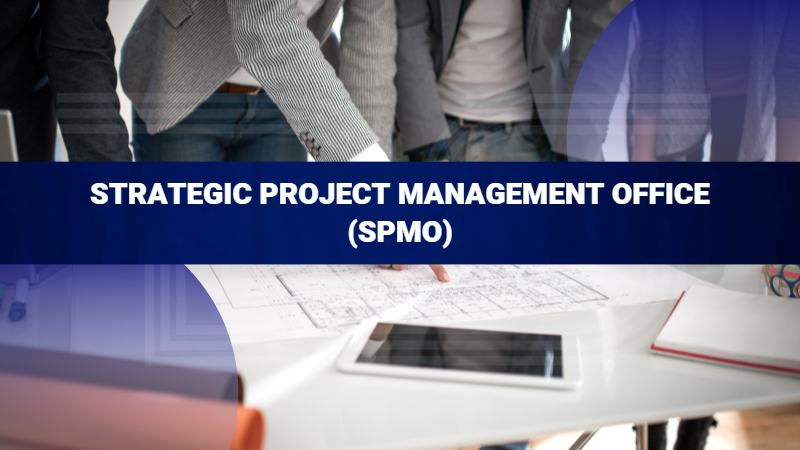
by DharamCW | May 7, 2023 | General
The project management office (PMO) is increasingly evolving from an administrative role to one that is strategic and more closely connected with business drivers. As a result, the PMO plays an important role in generating corporate value as the pace of business rises along with the expectation of faster returns on investment.
Traditional administrative PMOs fall short of meeting this need. Therefore, a mindset change and a reinvented project delivery capability that is both commercially astute and agile are required. Furthermore, such a PMO must comprehend and implement the plan.
In this article, we’ll look at the factors driving the shift to strategic project management offices (SPMO), also known as Enterprise PMO or EPMO, the essential features of a value-adding PMO, and game changer ideas to help you alter your PMO and improve its profile in your business.

What is Strategic PMO (SPMO)?
Strategic PMO (SPMO)
A Strategic PMO is a project-centric business department that should be structured and managed like other business departments – with enterprise leadership setting goals and objectives that assist the organization in thriving. The demands of individual organizations will lead to variations in what it means in specific terms. Still, we can expect a focus on the following areas:
- Portfolio management – Generation of ideas, selection, execution, and realization of benefits. Portfolio Management is a huge area, and organizations will adapt to it as it becomes increasingly crucial.
- Financial management – The PMO, closely linked to portfolio management, must be accountable for ensuring that project investments are acceptable and fit with business goals. The PMO must also guarantee competent budget management during project execution. Furthermore, the PMO should be held accountable for monitoring and tracking the benefit realization tasks of the business units.
- Enterprise-wide project-related processes and approaches Strategic risk management (i.e., managing the portfolio’s organizational risk exposure, proactive risk selection to match organizational tolerance, and so on), integration of finance and benefits, consistent quality standards, and so on.

Focus areas of Strategic PMO
- Proactive resource management – Capacity and capability planning, skills inventory management, and so on – ensuring that the project execution functions have the appropriate people with the right skills at the right time.
- Strategic partner – This borders on cultural change, creating the PMO as an independent and impartial consultant to the organization on project execution. PMOs, like IT, must demonstrate that they are business leaders supporting the organization’s work rather than a tactical execution-only function.
Different levels of PMO strategic alignment
Within an organization, a PMO can function at three stages of ‘Strategic’ maturity:

Different levels of PMO strategic alignment
- Strategy Creation – Strategy Creation entails assisting organizations in determining which strategic options to pursue (and then translating them into projects – Strategy Delivery – and managing their success – Strategy Management). It is unusual for a PMO to achieve this level of trust and influence inside an organization. Still, it is the (possible) future for the enterprise PMO that is effectively embedded within an organization and fortunate with the right sponsorship.
- Strategy Delivery – Strategy Delivery is the process through which the PMO turns important strategy objectives into new projects to be added to the portfolio (and perhaps to remove some from the portfolio if such objectives have changed). The ‘Strategy Supervision’ capability backs up this ‘Strategy Delivery’ capability. The PMO may also take direct responsibility for the execution of large and complex programs (or projects) that are specifically critical to a key strategic effort, such as relocation activities.
- Strategy Supervision – Strategy Supervision of strategic intents through project ownership, each of which should directly or indirectly link to a strategic intention of the overall organization. ‘Strategy Supervision’ is where the PMO acts as the Executive’s governing and advisory body by:
- Validating that all projects undertaken correspond to one or more strategic initiatives.
- Monitoring the current and right alignment of projects and strategy.
- Making stall-and-kill recommendations for initiatives no longer correspond with current corporate strategic thinking.
Five Steps to Creating the Strategic Enterprise Project Management Office (SPMO)
Today’s organizations recognize that fewer and fewer initiatives are self-contained inside individual departments and increasingly straddle multiple business functions. Project management offices (PMOs) have traditionally been connected with IT, partly due to technology’s role in all projects. However, with technology increasingly transitioning to contribute to those business transformation initiatives, keeping the PMO as an IT role is ineffective.
The appropriate response to this trend is a single, enterprise-wide EPMO. Many firms using EPMOs, however, fail to perceive an increase in project execution speed. In addition, here are the five key steps to achieving long-term EPMO success:

Five Steps to Creating SPMO
- Define the company’s goal.
- Create appropriate leadership and accountability structures.
- Communicate the purpose, responsibilities, and alignment.
- Respond to measurements and outcomes.
- Create a road map for actual evolution into a business function.
The Rise of the Strategic PMO
The strategic PMO may play a crucial role as a custodian and evangelist for business benefits realization, giving important information to the Executive on which projects deliver value across the organization. In addition, the insights provided by the SPMO may help with crucial decisions like which initiatives to fund, which projects to kill, or re-prioritizing or re-balancing work portfolios to reflect changing business or market conditions.
Not all PMOs must be strategic in character. For example, a PMO embedded within a project or program might focus on the project’s day-to-day resource management and administrative needs. However, the decision to start the project should have been taken at a strategic level. From the start, the project-level PMO should have been aligned with the Strategic PMO’s reporting and governance structure. The SPMO should be able to make micro and macro business choices based on accurate and timely project data flow up into the program and, eventually, portfolio level.
The Strategic PMO plays a key role in championing and driving business value for the organization and being an effective change enabler. Here are the five major game changers that will propel the PMO and project organization to the next level.

5 Major game changers that will propel the PMO and project organization to the next level
- Demonstrating Project Leadership and Vision
- The Importance of Realistic Planning
- A Culture of Disciplined Execution
- Effective Stakeholder and Change Management
- Creating a “Value Lens” for Managing Enterprise Investment
The strategic project management office is critical to increasing project maturity and optimizing the organization’s business return on project investment. People, processes, data, and technologies must all be prioritized to achieve this objective. Project management is a multifaceted endeavor that is both an art and a science.
Leveraging the future of PMO to drive new strategic opportunities
In recent years, businesses have been subjected to a slew of external forces, the most significant of which has been Covid-19. These disruptors have caused firms to adapt, whether to work around obstacles, shift to new working methods, or adapt to Industry 4.0. All of these variables influence organizational complexity, both strategically and operationally. Businesses must not only respond proactively to all of this complexity; they must also prosper while operating in a resource-constrained environment. As a result, today, more than ever, the PMO’s ability to efficiently deliver projects and transform organizations of all kinds and across many locations is critical to achieving their goals.
Projects must be completed at scale to create transformation for a company effectively. A McKinsey & Company study of over 5000 large-scale projects discovered that 56% generated less value than planned, 45% went over budget, and 17% were so disastrous that the organization’s survival was threatened. This study highlights the need to make adequate efforts to select PMOs who can adapt to the future of work.
Historically, PMOs have been viewed as lacking a clear identity or purpose within an organization; however, the future-state PMO is an enabler of business value creation, collaborating with business leaders to provide a clear and achievable roadmap while making the best use of the organization’s limited resources.
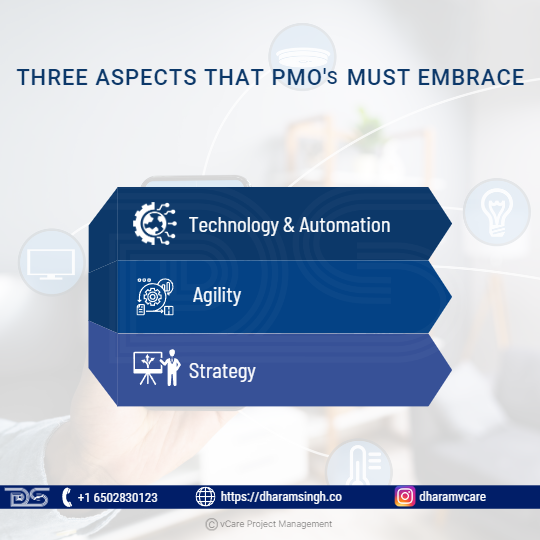
3 Aspects that PMOs must embrace
PMOs must also adjust to the new normal and growing business demands. The three areas described below represent the fundamental features that PMOs of the present and future must embrace to manage change effectively.
- Technology & Automation
Because Covid-19 has accelerated the way we utilize technology in our daily work, technology is expected to be front and center, enabling PMOs to deliver more successfully. To effectively adapt to new methods of working and build a “single source of truth,” advanced technologies and cloud-based solutions will be required. This technology jump is critical for borderless operations in which progress and transparent communication must be readily available and updated in real-time to allow for swift decision-making.
In the future world, both artificial intelligence and machine learning will be important facilitators of automating PMO procedures, delivering superior insights, and allowing teams to spend less time on manual transactional processing and more time generating value for projects. For example, project planning is often based on data collection, industry benchmarking, and using the experience of project managers. However, according to PMI – AI Innovators, there is still a significant inefficiency in project management, with around 1/3 of traditional project management activities requiring one or more days of manually collating reports. Using IoT and big data to automate various tedious processes allows the PMO to create more realistic and effective timetables and spot potential disruptors.
However, it is unlikely that technology will completely replace project managers, with the PMI forecasting that businesses will require over 88 million project managers by 2027. As a result, PMs will be expected to improve their competencies and fully utilize the available technologies.
PMOs will be required to lead by example in their automation projects, advocating new methods of working with their collaborative organization in the future. As a result, the paradigm of efficiently providing workstreams may evolve, driving firms to become more digital.
- Agility
With an increased level of complexity for transformation and multiple stakeholders to handle, projects may need to adapt and pivot in other ways than originally planned. Changes in priorities (39%) and objectives (37%) and the inability to adapt are the two leading reasons for project failure, according to PMI.
As a result, PMOs that can be responsive to change needs continually are critical to fulfilling project milestones, which might mean the difference between being an industry leader or a laggard. An agile PMO’s guiding principles are as follows:
- Decentralization of planning and decision-making
- Agile resource allocation and reallocation
- Workflows that are effective for continuous project advancement
An agile PMO may demonstrate agility by altering priorities and reallocating resources to achieve new objectives while transitioning seamlessly from reorganization to continuous delivery. Furthermore, decisions are decentralized, allowing faster response rates for recognizing and reducing hazards. Finally, communication is critical, with fewer layers of approval, and output is assessed by how much work can be done in a particular sprint.
However, merely establishing an agile PMO will only solve some difficulties; 47% of agile projects are late, have budget overruns, or result in dissatisfied consumers. A cultural revolution is required to fully realize agile’s potential, beginning with the leadership team and spreading across the firm.
As a result, the PMO cannot only act as an intermediary but also as a business partner, working alongside the leadership team and the rest of the organization. Team members must be self-sufficient, accountable, and have complete insight into project progress and data.
- Strategy
The PMO’s role must evolve from a team offering mere assurance to becoming a strategic partner with a vested interest in aligning with the organization’s ability to carry out its plan. As a result, the team is expected to have stronger strategic oversight of all work streams to deliver value throughout the project.
PMOs will be required to go beyond task completion and monitoring to include:
- Portfolio planning entails generating ideas for the activities required to capitalize on the opportunity.
- Project prioritizing entails determining the most effective timeframe and budgeting by the company’s demands.
- Capacity planning entails assigning the appropriate skills and resources to each work team.
- Resilience planning entails anticipating future obstacles and reducing interruptions.
- The strategic partnership is a cultural transformation in management and the PMO. The PMO is viewed as a business leader and adviser with a stake in the organization’s goals.
The key to success is consistent stakeholder engagement, with the PMO and business leaders holding frequent strategic discussions to monitor and coordinate company strategy and broad strategic objectives. This consistency will build a collaborative strategic management process and a fluid communication channel to adjust quickly and efficiently.
The future PMO will be more strategic and intricate in character than conventional models, emphasizing driving decision-making, execution, and outcomes while becoming more decentralized to interact with each workstream to achieve one common goal efficiently. Finally, PMOs will be more crucial than ever in addressing the complexities that organizations are now confronting. An effective transformation will need PMOs to serve as the organization’s voice and face.

Strategic project management office’s role in strategy execution
Strategic project management office’s role in strategy execution
Identifying, implementing, and managing strategic initiatives is critical to strategy execution. The strategies are implemented by creating strategic initiatives to support strategic objectives and fill gaps in strategic measures, and the value gap is bridged. Only projects that are connected with the strategic goal should be accepted.
When defining strategic initiatives/projects, the sequence of initiative execution is crucial since all related strategic initiatives must finish and provide value. The strategic initiatives cover almost all departments and corporate shared services. As governance becomes more important in project management, portfolios and programs are defined.
- Strategic initiatives are linked to similar programs and project execution.
- The projects will be managed by program managers, project managers, and another project team.
- Connecting programs and projects creates portfolios for portfolio managers and other project governance teams.
- Project, program, and portfolio definition is an iterative process reviewed multiple times to ensure interconnectivity and value generation.
Portfolio, program, and project management are critical components of strategy execution. Hence, everything is referred to as a Strategic Project Management Office (SPMO) or Enterprise Project Management Office (EPMO).
Final Thoughts
Organizations can only thrive in a highly competitive world if they innovate. Such innovation must occur at all levels of the organization, including goods, services, business processes, and business models.
The PMO has the authority to execute the innovation at all levels. Good project management regulates and fosters innovation through projects—customer satisfaction and profit growth when consistent outcomes are predictable. Project and program management practices establish the foundation for dependable plan execution. The efficacy of the organization’s initiatives and programs will influence corporate success when such practices are implemented throughout the organization.
The project management office (PMO) is a key change management component, working with other organizational structures, such as functional units, to improve project management competencies. However, in today’s competitive environment, businesses must rely on more than just solid strategies to secure success.
To succeed, managers must build organizations capable of attaining their strategic objectives faster than their competitors. This initiative involves the creation of organizations capable of performing today’s tasks more effectively while anticipating future disruptions. Successful execution of creative and strategic concepts leads to innovation. Competitive advantage is as much about execution as it is about strategy.
Feel free to check out my discussion on this topic with Justin Buckwalter in YouTube
For any questions related to your Project Management career, training, and certifications, you can book an obligation free 15 minutes session with me by visiting http://talktodharam.com/
You can subscribe to the vCare Project Management YouTube Channel to catch future videos of our Q&A series and certification success stories: https://bit.ly/2YF0wJl
You can subscribe to and follow my podcasts and interviews with Project Management Experts on YouTube at https://bit.ly/2NDY8wd




























Recent Comments